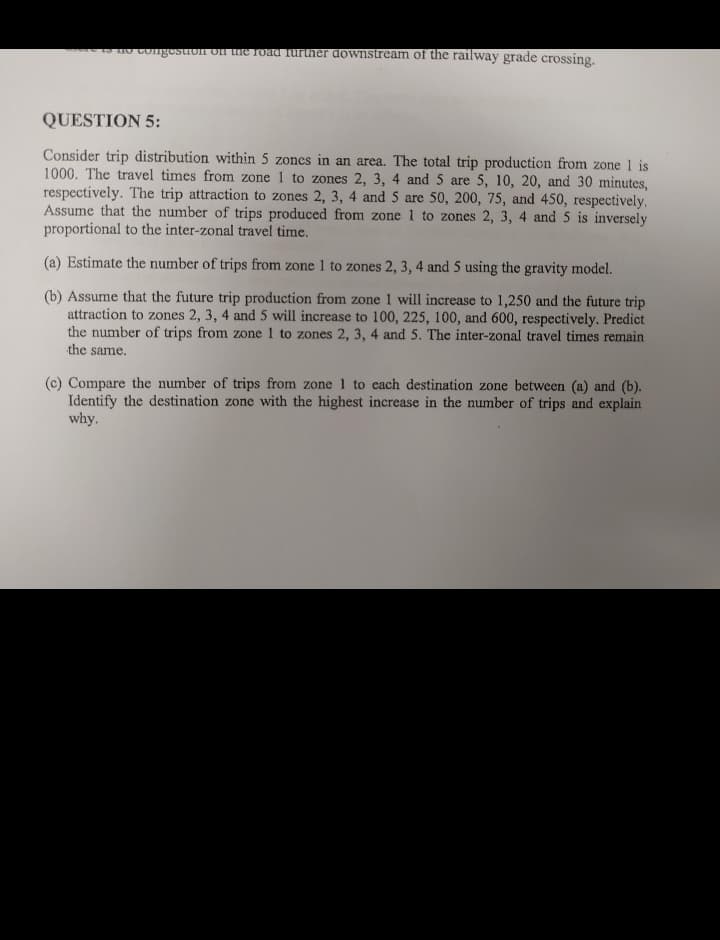congestion on the road further downstream of the railway grade crossing. QUESTION 5: Consider trip distribution within 5 zones in an area. The total trip production from zone 1 is 1000. The travel times from zone 1 to zones 2, 3, 4 and 5 are 5, 10, 20, and 30 minutes, respectively. The trip attraction to zones 2, 3, 4 and 5 are 50, 200, 75, and 450, respectively. Assume that the number of trips produced from zone 1 to zones 2, 3, 4 and 5 is inversely proportional to the inter-zonal travel time. (a) Estimate the number of trips from zone 1 to zones 2, 3, 4 and 5 using the gravity model. (b) Assume that the future trip production from zone 1 will increase to 1,250 and the future trip attraction to zones 2, 3, 4 and 5 will increase to 100, 225, 100, and 600, respectively. Predict the number of trips from zone 1 to zones 2, 3, 4 and 5. The inter-zonal travel times remain the same. (c) Compare the number of trips from zone 1 to each destination zone between (a) and (b). Identify the destination zone with the highest increase in the number of trips and explain why.
congestion on the road further downstream of the railway grade crossing. QUESTION 5: Consider trip distribution within 5 zones in an area. The total trip production from zone 1 is 1000. The travel times from zone 1 to zones 2, 3, 4 and 5 are 5, 10, 20, and 30 minutes, respectively. The trip attraction to zones 2, 3, 4 and 5 are 50, 200, 75, and 450, respectively. Assume that the number of trips produced from zone 1 to zones 2, 3, 4 and 5 is inversely proportional to the inter-zonal travel time. (a) Estimate the number of trips from zone 1 to zones 2, 3, 4 and 5 using the gravity model. (b) Assume that the future trip production from zone 1 will increase to 1,250 and the future trip attraction to zones 2, 3, 4 and 5 will increase to 100, 225, 100, and 600, respectively. Predict the number of trips from zone 1 to zones 2, 3, 4 and 5. The inter-zonal travel times remain the same. (c) Compare the number of trips from zone 1 to each destination zone between (a) and (b). Identify the destination zone with the highest increase in the number of trips and explain why.
Traffic and Highway Engineering
5th Edition
ISBN:9781305156241
Author:Garber, Nicholas J.
Publisher:Garber, Nicholas J.
Chapter2: Transportation Systems And Organizations
Section: Chapter Questions
Problem 4P
Related questions
Question

Transcribed Image Text:to no congestion on the road further downstream of the railway grade crossing.
QUESTION 5:
Consider trip distribution within 5 zones in an area. The total trip production from zone 1 is
1000. The travel times from zone 1 to zones 2, 3, 4 and 5 are 5, 10, 20, and 30 minutes,
respectively. The trip attraction to zones 2, 3, 4 and 5 are 50, 200, 75, and 450, respectively.
Assume that the number of trips produced from zone 1 to zones 2, 3, 4 and 5 is inversely
proportional to the inter-zonal travel time.
(a) Estimate the number of trips from zone 1 to zones 2, 3, 4 and 5 using the gravity model.
(b) Assume that the future trip production from zone I will increase to 1,250 and the future trip
attraction to zones 2, 3, 4 and 5 will increase to 100, 225, 100, and 600, respectively. Predict
the number of trips from zone 1 to zones 2, 3, 4 and 5. The inter-zonal travel times remain
the same.
(c) Compare the number of trips from zone 1 to each destination zone between (a) and (b).
Identify the destination zone with the highest increase in the number of trips and explain
why.
Expert Solution
This question has been solved!
Explore an expertly crafted, step-by-step solution for a thorough understanding of key concepts.
This is a popular solution!
Trending now
This is a popular solution!
Step by step
Solved in 4 steps with 3 images

Knowledge Booster
Learn more about
Need a deep-dive on the concept behind this application? Look no further. Learn more about this topic, civil-engineering and related others by exploring similar questions and additional content below.Recommended textbooks for you

Traffic and Highway Engineering
Civil Engineering
ISBN:
9781305156241
Author:
Garber, Nicholas J.
Publisher:
Cengage Learning

Traffic and Highway Engineering
Civil Engineering
ISBN:
9781305156241
Author:
Garber, Nicholas J.
Publisher:
Cengage Learning